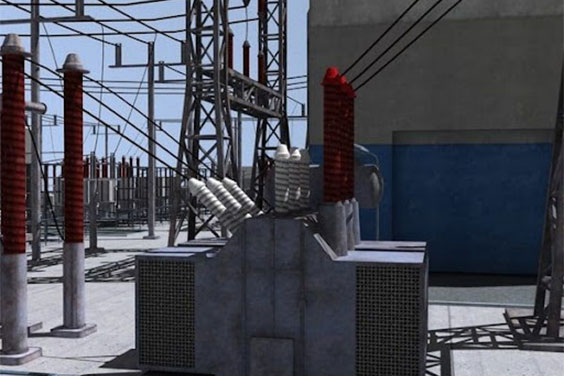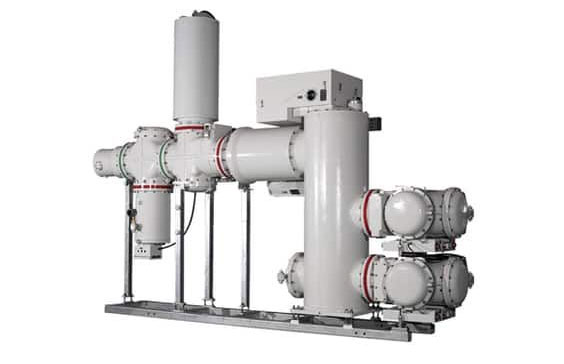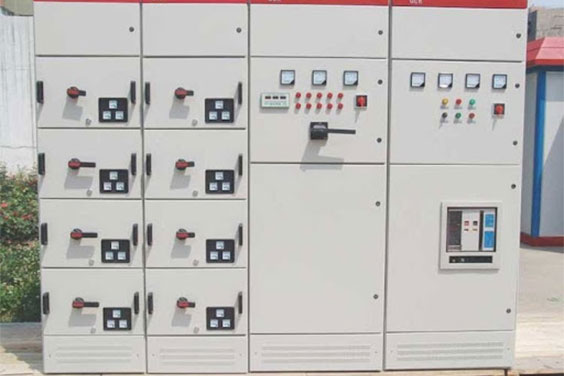
In recent years, the demand for electricity has surged on a regular basis, forcing enterprises to construct a variety of power plants to ensure a steady supply. However, several other protective types of machinery should be used in electric stations to safely transmit electric power. Substations are one of them.
The electrical distribution, transmission, and generation systems all include substations. Since the flow of current is not always consistent, a device must be used to transition high voltage electricity into low voltage power appropriate for consumer distribution. This equipment is known as a substation.
Gas insulated substation and air-insulated switchgear are the two types of insulated substations. Let’s look more closely at the distinctions between them.
What is a GIS Switchgear/Substation?

The essential electric live components of a GIS gas insulated switchgear are encased within a metal cabinet filled with a dielectric gas known as SF6 in a gas-insulated substation system. Sulfur hexafluoride gas, generally known as SF6, is a harmless gas with enhanced dielectric characteristics compared to other gases. Hence, they provide beneficial insulation for phase to phase and phase to ground moderating.
In addition to its dielectric qualities, SF6 is a non-toxic gas that is safe to handle. SF6 also has outstanding arc quenching properties, rapid cooling properties and preserves atomic and molecular properties even at voltage spikes.
The gas is encased in a metal enclosure with other components like wires, current and voltage transformers, circuit breaker interrupters, switches, and lightning arrestors in the substation system.
What Is an AIS Switchgear/Substation?

Unlike gas insulated substations (GIS), Air insulated substations employ atmospheric air as their dielectric gas medium. AIS was the sole option for substation prior to the use of GIS.
They are widely used in rural areas and ideal for offsite terrain, where space, weather conditions, seismic events, and environmental issues are not an issue.
AIS comprises air-insulated technology components such as circuit breakers, disconnectors, surge arrestors, instrument transformers, power transformers, capacitors, bus bars, and so on, which are connected to each other by conductors, tubes, or subterranean power cables, in addition to air.
The most commonly used type of substation is the AIS, which represents more than 70% of all substations worldwide.
AIS vs GIS Substation
Aside from the dielectric media used, AIS and GIS have a lot of notable distinctions. They are described in full further down.
Advantages
Advantages of AIS substation:
The advantages of AIS substation are
1. They are the optimal choice for building substations in places with a lot of space.
2. AIS switchgear does not necessitate significant costs. In comparison to GIS switchgear, they can be built at a reasonable expense.
3. In comparison to HV GIS substations, AIS substations are constructed quicker.
4. Because the equipment is transparent, they do not require frequent or expensive maintenance if any faults arise. It would be easier and swiftly detected.
Advantages of GIS substations:
The advantages of GIS substations are
1. The hv GIS substation is housed in a metal shell, ensuring a secure working environment.
2. Minimal space is required in a conventional AIS system because the distance between active and non-active switchgear sections is minimized.
3. The components are separated into compartments, making it easy to connect and assemble them accurately.
4. GIS substations, like AIS, do not require extensive maintenance because they are built to provide maximal protection from the environment.
5. The SF6 gas is known not to deplete or age for approximately 40 years. So, it isn’t necessary to replace it regularly.
6. GIS can be assembled quickly.
Disadvantage
Advantages of GIS substations:
The advantages of GIS substations are
1. Air insulated switchgear requires more territory than gas insulated substation because they are designed to be erected in large spaces.
2. It has a set of maintenance requirements that must be met regularly, which can be pricey.
3. When compared to SF6 gas insulated switchgear, the air is a poor dielectric medium. Moisture, as well as secondary elements such as humidity and pollution, necessitates additional room for efficiency.
Disadvantages of GIS substation:
GIS substations have several disadvantages.
1. Installing a GIS substation requires high capital.
2. Transporting SF6 gas supplies through rugged terrain can be much more economical.
3. GIS gas insulated substations also necessitate a lot of upkeep. Maintenance should also be conducted by highly trained personnel.
4. Internal faults should be rectified as quickly as possible, which might be pricey in a GIS switchgear.
5. GIS substation breakdowns frequently result in lengthy outages.
6. Though the gas is primarily innocuous, it can be broken down into dangerous by-products such as metal fluoride powders due to flash difficulties. This can result in physical asphyxiation and other breathing difficulties, which can be hazardous to one’s health.
Primary Hardware
For primary equipment, you’ll need primary hardware. The cost of auxiliary equipment such as supports, cables, land, construction, control, security, and monitoring, on the other hand, can result in a minor cost difference between the two systems.
Maintenance
SF6 gas insulated switchgear requires substantially less upkeep. GIS systems, on average, only need to be visually checked every four years or more, depending on the medium voltage switchgear manufacturers’ advice for your system.
Lubrication can be done in GIS systems for roughly 20 years. When greasing, make sure to follow the switchgear company instructions.
AIS systems should be inspected regularly based on the specific manufacturer’s recommendation every year to two years. Unlike GIS gas insulated substation, where individual compartments and elements are thoroughly insulated and monitored, all compartments must be reviewed when inspecting. For every two years, an AIS breaker will require roughly four hours of maintenance.
AIS systems demand substantially more effort in terms of maintenance, owing to the complexity of the inspections. A technician will torque, draw out, clean, lubricate, and vacuum the device as part of the inspection. They should also be checked for visible signs of copper oxidation, which does not occur in medium voltage gas insulated switchgear because the units are sealed. The components are also protected from environmental harm by sealing.
Because the probability of failure of circuit breakers and disconnectors in MV GIS is lower than that of AIS over its lifetime, the maintenance cost of mv GIS is lower than that of AIS switchgear.
Operation
In terms of its operations, GIS systems are much easier to manage on a routine basis because they have frontal access rather than rear access. They also have their own built-in testing equipment.
A flashover of electric current departs its intended path and travels through the air from one conductor to another or to the ground, which is known as an arc flash. Arc flashes can occur in electric systems, but they’re uncommon in GIS switchgear because all of the inside components are shielded, and only the cable compartment is accessible. No cables or links can come into contact with the live conductors because they are totally insulated.
MV GIS switchgear training is more expensive than AIS switchgear training.
Design Characteristic
Because air insulated substations must be installed in an upscale area of space, they are usually found outside. The internal components with the AIS air insulated switchgears are also expected to be air-insulated. Some other characteristics for AIS switchgear are
- Less construction time
- Best suited for substations with low voltage ratings.
- Extensive spacious area
- Safe to place outdoors.
Gas insulated substations are usually placed indoors. High voltage gas insulated switchgear designs are intended to be used in situations where one or more of the following properties are desirable:
- Limited space
- Extreme weather conditions
- Required low environmental impact
- Less maintenance
Cost
The initial capital outlay is insufficient to assess the entire substation project in terms of economics. Primary hardware, maintenance, operation, outage, and disposal costs should all be considered to evaluate the overall cost.
The following is a cost comparison of AIS switchgear and GIS gear:
- Primary hardware is used since both substations are primary machinery. The cost of equipment such as support, conductors, land, installation, management, protection, and surveillance is usually high. This can result in a minor cost difference between the two systems.
- Primary hardware is used since both substations are primary machinery. The cost of equipment such as support, conductors, land, installation, management, protection, and surveillance are usually high. This can result in a minor cost difference between the two systems.
- Since the probability of failure of circuit breakers and disconnectors is lower in GIS, the maintenance cost of hv GIS is cheaper compared to AIS.
- GIS training is much more expensive than AIS training.
The cost depends on various factors. To calculate the overall cost, After-use decommissioning and disposal costs should also be budgeted.
Environment Effect
Though both AIS air insulated switchgear and GIS gear are essentially harmless, there are specific environmental effects to be mindful of since substations necessitate the use of power and gas, both of which should be protected at all costs. The following are the environmental implications of mv GIS and AIS:
Noise
When air-insulated circuit breakers and load break switches are triggered, they can generate a high amount of momentary noise. Other noise sources from switching equipment in a substation include corona discharges, arcing while switches are in operation, and so on.
Since the machinery in HV GIS installations is wholly enclosed, the noise levels are lower. The SF6 gas in the enclosures is a convenient and efficient sound absorber since new arc interruption technologies in SF6 gas demand lower energy levels, smaller, spring-operated devices with lower noise levels have been developed.
Gas leakage
Under certain conditions, the fluids utilized, such as SF6 gas and other lubricating oils, can escape into the environment. Since SF6 is classified as a greenhouse gas, manufacturers and consumers should take all necessary precautions to prevent construction and operational leakage.
To combat gas leakage, numerous countermeasures are generally taken. However, when comparing the two substations, the length of sealed surfaces within AIS and GIS differs. Within GIS, the whole length of SF6 seals is the longest. However, in AIS, oil-filled equipment may well be placed. However, because GIS equipment is usually installed indoors, it reduces environmental exposure while also increasing the life of the sealing systems.
In terms of gas leakage, HV GIS systems are safer compared to AIS.
In addition to the above, the manufacturer provides extensive instructions for installation, service, maintenance, repair, and correct disposal in order to reduce handling losses.
Weather conditions
All technologies must be designed to withstand the weather parameters such as temperatures, humidity, ice, rain or snow, wind, solar radiation, and so onat the installation site. In this scenario, there is no significant difference between systems.
On the other hand, MV GIS systems are typically installed indoors, so they don’t have to be concerned about the weather.
Pollution
Pollution has a proportional influence on switchgear based on the number of insulators and bushings in that switchgear. As a result, more compact medium voltage gas insulated switchgear systems offer some significant benefits. Naturally, medium voltage switchgear has more advantages than outdoor AIS.
Corrosion
Corrosion is inherent in any outdoor-installed equipment due to environmental influences, including even exposure to extreme conditions such as acid rain, marine environments, or man-made pollutants.
However, because GIS is frequently deployed indoors, it is more advantageous than AIS in this instance.
Seismic conditions
If the substation is situated in an area with seismic activity, proper engineering design and seismic testing in compliance with the relevant requirements must be employed, regardless of technology.
An AIS, on the other hand, is more likely to be damaged after an earthquake due to individually installed structures and foundations, but the GIS, due to its design, may react more solidly.
Because of their compactness and low center of gravity, GIS installations function best in seismic circumstances.
Conclusion
Regardless of their difference, It is up to power plant proprietors to determine which substation to install in their power plants.
If you’re looking for high-quality air and gas-insulated power stations, have a look at our switchgear service, which is the professional switchgear manufacturing company. Electrical switchgears here are built to the highest safety standards.

